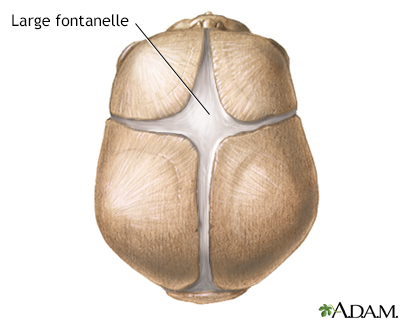Fontanelles - enlarged
Soft spot - large; Newborn care - enlarged fontanelle; Neonatal care - enlarged fontanelle
Enlarged fontanelles are larger than expected soft spots in the head for the age of a baby.
The skull of an infant or young child is made up of bony plates that allow for growth of the skull. The borders at which these plates intersect are called sutures or suture lines. The spaces where these connect, but are not completely joined, are called soft spots or fontanelles (fontanel or fonticulus).

The sutures or anatomical lines where the bony plates of the skull join together can be easily felt in the newborn infant. The diamond shaped space on the top of the skull and the smaller space further to the back are often referred to as the soft spot in young infants.

Fontanelles are the soft spots on an infant's head where the bony plates that make up the skull have not yet come together. It is normal for infants to have these soft spots, which can be seen and felt on the top and back of the head. Fontanelles that are abnormally large may indicate a medical condition.

A wide fontanelle occurs when the fontanelle is larger in size than expected for the age of the baby. Slow or incomplete ossification of the skull bones is most often the cause of a wide fontanelle.

The bones of the skull are not joined together firmly at birth. The sutures gradually accumulate minerals and harden (this process is called ossification), firmly joining the skull bones together. In an infant, the spaces where sutures intersect but don't completely touch is called the soft spot, a membrane covered area also called a fontanelle (fontanel or fonticulus). The fontanelles allow for growth of the skull during an infant's first year. When the spaces of the fontanelles are larger than normal underlying causes such as hydrocephalus may be suspected.
Considerations
Fontanelles allow for growth of the skull during an infant's first year. Slow or incomplete closure of the skull bones is most often the cause of a wide fontanelle.
Causes
Larger than normal fontanelles are most commonly caused by:
- Down syndrome
- Hydrocephalus
- Intrauterine growth retardation (IUGR)
- Premature birth
Rarer causes:
- Achondroplasia
- Apert syndrome
- Cleidocranial dysostosis
- Congenital rubella
- Neonatal hypothyroidism
- Osteogenesis imperfecta
- Rickets
When to Contact a Medical Professional
If you think that the fontanelles on your baby's head are larger than they should be, talk to your health care provider. Most of the time, this sign will have been seen during the baby's first medical exam.
What to Expect at Your Office Visit
An enlarged large fontanelle is almost always found by the provider during a physical exam.
- The provider will examine the child and measure the child's head around the largest area.
- The provider may also turn off the lights and shine a bright light over the child's head.
- Your baby's soft spot will be regularly checked at each well-child visit.
Blood tests and imaging tests of the head may be done.
References
Kinsman SL, Johnston MV. Congenital anomalies of the central nervous system. In: Kliegman RM, St. Geme JW, Blum NJ, Shah SS, Tasker RC, Wilson KM, eds. Nelson Textbook of Pediatrics. 21st ed. Philadelphia, PA: Elsevier; 2020:chap 609.
Piña-Garza JE, James KC. Disorders of cranial volume and shape. In: Piña-Garza JE, James KC, eds. Fenichel's Clinical Pediatric Neurology. 8th ed. Philadelphia, PA: Elsevier; 2019:chap 18.
Version Info
Last reviewed on: 11/6/2023
Reviewed by: Neil K. Kaneshiro, MD, MHA, Clinical Professor of Pediatrics, University of Washington School of Medicine, Seattle, WA. Also reviewed by David C. Dugdale, MD, Medical Director, Brenda Conaway, Editorial Director, and the A.D.A.M. Editorial team.
